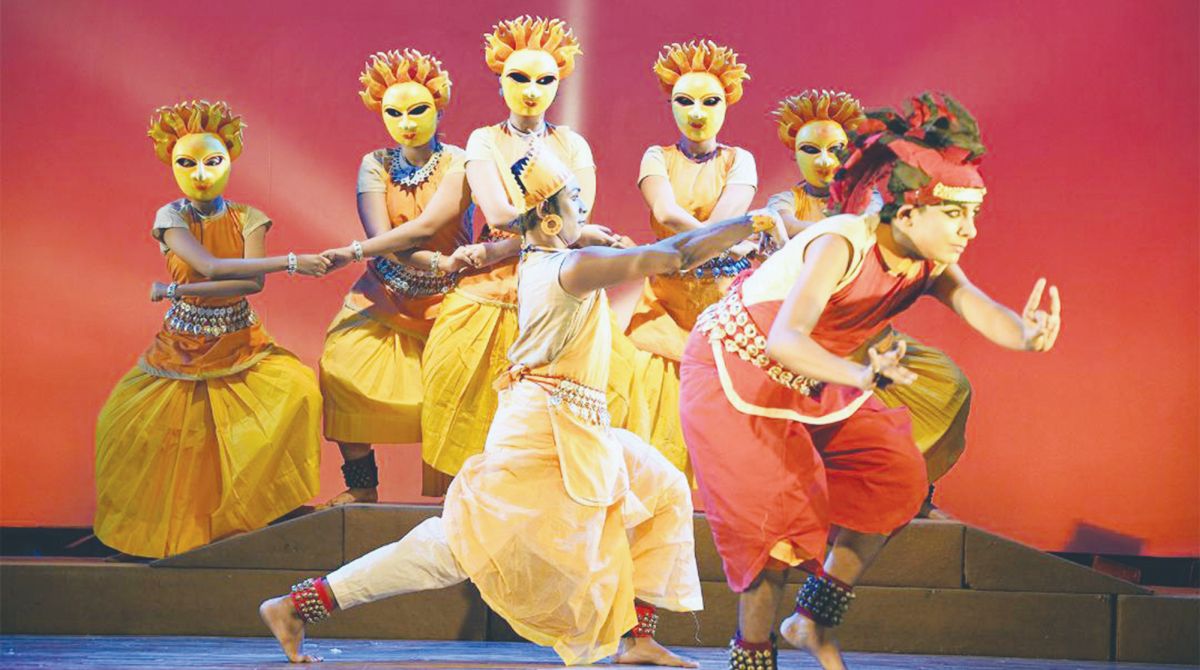At the masters feet
It was a happy collection of dancers that had gathered to showcase the timelessness of Guru Kelucharan Mohapatra’s choreographic works.…
A bouquet of beautiful renditions showcased the varied bounty of Indian classical dance.

Vahanas
Mythological stories dealing with the activities of gods and goddesses, their consorts and their progeny have always been a subject matter of the traditional dances of India.
Gurukul, a dance institution-founded by artistic director Sutapa Talukdar, however, had a different take. A disciple of legendary Odissi Guru Kelucharan Mohapatra, Talukdar took a peek into the animals and birds that the gods use as their vehicles or vahanas to tell their stories. Some of those animals exist in our world while some are mythical.
Thus one got a glimpse of Agni’s goat, Indra’s elephant, Pavana’s deer, Surya’s stallion, Ganga’s makara (a mythical sea animal), Durga’s lion, Lakshmi’s owl, Saraswati’s white swan, Yama’s buffalo, Shiva’s bull, Kartikeya’s peacock and Ganesha’s rodent on stage. They all had props to identify them, like the rodent had a huge tail; the elephant had large ears and so on.
Advertisement
The rich vocabulary of Odissi has hasta mudras, gestures and dance movements to single out these animals but perhaps Talukdar designed the show keeping in mind unschooled and lay audiences too. Each of the vahanas appeared with their deities and told their stories in the idiom of Odissi and Chhau. Resplendent in a red costume, Talukdar herself was Durga who came astride her vahana to tell her story.
While each of the deities and their vahanas told their story, a priest prayed to a picture of that particular deity in a corner of the stage. That added to the grand spectacle. Drama and dance went hand in hand with the fighting of the animals and the activities of the gods, accompanied with Sanskrit shlokas and chants taken from the Vedas, Puranas and other ancient texts.
The Sanskrit script was with the help of Shanghamitra Mukherjee and Saveri Rakshit. However, the heavily-accented English commentary did not seem to match with the scheme of things. The costumes, light designing by Uttam Jena, musical accompaniment by Subhankar Banerjee complemented the performances quite well.
Talukdar’s passionate commitment in her chosen field unfolded at Satyajit Ray auditorium of ICCR Kolkata. The performers who accompanied Talukdar to tell her well-researched stories were Payel Mazumder Mandal, Subhabrata Chatterjee, Subhasish Acharya, Sourav Samanta, Madhuparna Mondal, Souvik Modak, Priyasha Maitra, Ishani Boral, Oishani Bhattacharjee, Procheta Roy, Anusha Paul, Shreetama Ganguly, Shreya Dutta Majumdar, Rouhi Sanyal, Sankhadip Kayal and Suresh Barman.
***
Kolkata Mayur Lalit Dance Academy, directed by Debomitra Sengupta, a noted Odissi dancer, choreographer and a senior disciple of Guru Kelucharan Mohapatra and Sutapa Talukdar, presented Ritu Bichitra, which sang the glory of seasons, using Hindustani ragas and Rabindra sangeet. The Odissi idiom with its all abounding grace lends well to innovations. Sengupta used her knowledge of the form to her advantage.
Her Ritu Bichitra was choreographed well and she won half the battle because of the powerful musical content. A lot of creativity could be seen in costume designing, however, this area needs a little more thinking to give Ritu Bichitra a new dimension. The beauty of Ritu Bichitra would linger for long in the minds of the audience.
***
Kathaka Jalsa Chandra, founder and artistic director of Nritya Kalangan, who is also a reputed Bharatanatyam dancer trained under Kalamandalam Guru Thankamani Kutty, conducted a beautiful evening of dance at the University Institute Auditorium, College Street. In the first half of the evening, Chandra was the nattuvanar presenting her disciples in self-choreographed pieces in the Bharatanatyam style.
Guru Ranganathan Srinivasan provided vocal support, S Venkat Raman’s mridangam, Natraj Radha Krishnan’s violin; Debraj Bose’s striking notes on the synthesiser along with flautist Sekhar Deuri created a beautiful atmosphere. Shromona Dhara lent her voice wherever needed. Chandra proved her mettle in choreographing pieces like Swarajathi, Alarippu, Jathiswaram, Rabindrasangeet dance pieces, Ganga Stuti and Ritigowla Varnam.
Whether it was Ganga Stuti in ragam Yamuna Kalyan and adi taalam where devotees bowed down to the Ganga asking for salvation or asking Shiva’a blessings in Swarajathi, Chandra is seriously stretching her boundaries in the choreographic field.
It was a bright idea to sing a line or two of the song, Jharo jharo jhare ranger jharna and then sing the sargam, thereby giving the piece a new dimension rather than including jatis in between. Shiva’s Ananda Tandavam Varnam in ragam Riti Gowla, a composition of Ravi Shankar, was performed by three of Chandra’s disciples.
In the second half of the evening Chandra regaled the audience with a solo Kathak rendition beginning with Kali Stotram. She displayed her tayari in taal teental as learnt from Pandit Rajendra Ganghani, her present guru. She was initiated into Kathak at a tender age by Guru Kanan Sen.
Jhap taal by her students and a bandish of spring, Piya sang ki khelat holi brought the beautiful evening to an end. Musical support was given by Pratik Mukherjee on the tabla. Abira Mukherje gave vocal support while Vijay Mishra and Sekhar Deuri were on the sarangi and flute respectively. Bol Paranth was by Rajib Ghosh.
Advertisement